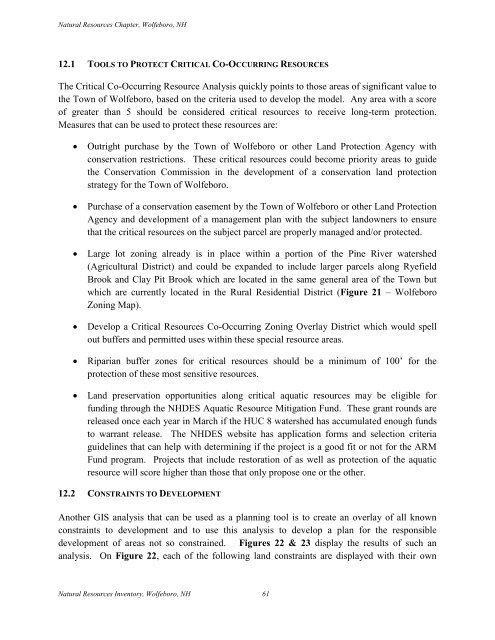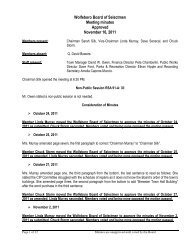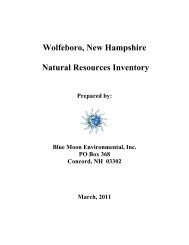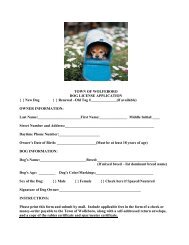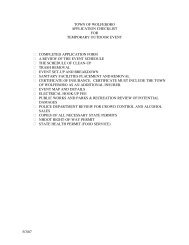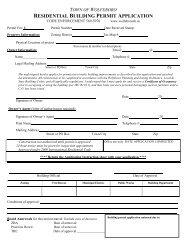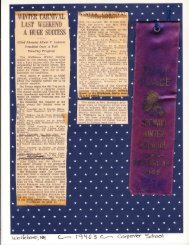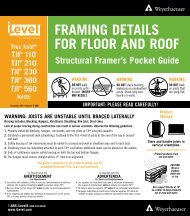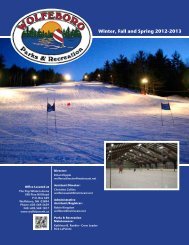Natural Resources Chapter of the Master Plan - Town of Wolfeboro
Natural Resources Chapter of the Master Plan - Town of Wolfeboro
Natural Resources Chapter of the Master Plan - Town of Wolfeboro
You also want an ePaper? Increase the reach of your titles
YUMPU automatically turns print PDFs into web optimized ePapers that Google loves.
<strong>Natural</strong> <strong>Resources</strong> <strong>Chapter</strong>, <strong>Wolfeboro</strong>, NH<br />
12.1 TOOLS TO PROTECT CRITICAL CO-OCCURRING RESOURCES<br />
The Critical Co-Occurring Resource Analysis quickly points to those areas <strong>of</strong> significant value to<br />
<strong>the</strong> <strong>Town</strong> <strong>of</strong> <strong>Wolfeboro</strong>, based on <strong>the</strong> criteria used to develop <strong>the</strong> model. Any area with a score<br />
<strong>of</strong> greater than 5 should be considered critical resources to receive long-term protection.<br />
Measures that can be used to protect <strong>the</strong>se resources are:<br />
<br />
<br />
<br />
<br />
<br />
<br />
Outright purchase by <strong>the</strong> <strong>Town</strong> <strong>of</strong> <strong>Wolfeboro</strong> or o<strong>the</strong>r Land Protection Agency with<br />
conservation restrictions. These critical resources could become priority areas to guide<br />
<strong>the</strong> Conservation Commission in <strong>the</strong> development <strong>of</strong> a conservation land protection<br />
strategy for <strong>the</strong> <strong>Town</strong> <strong>of</strong> <strong>Wolfeboro</strong>.<br />
Purchase <strong>of</strong> a conservation easement by <strong>the</strong> <strong>Town</strong> <strong>of</strong> <strong>Wolfeboro</strong> or o<strong>the</strong>r Land Protection<br />
Agency and development <strong>of</strong> a management plan with <strong>the</strong> subject landowners to ensure<br />
that <strong>the</strong> critical resources on <strong>the</strong> subject parcel are properly managed and/or protected.<br />
Large lot zoning already is in place within a portion <strong>of</strong> <strong>the</strong> Pine River watershed<br />
(Agricultural District) and could be expanded to include larger parcels along Ryefield<br />
Brook and Clay Pit Brook which are located in <strong>the</strong> same general area <strong>of</strong> <strong>the</strong> <strong>Town</strong> but<br />
which are currently located in <strong>the</strong> Rural Residential District (Figure 21 – <strong>Wolfeboro</strong><br />
Zoning Map).<br />
Develop a Critical <strong>Resources</strong> Co-Occurring Zoning Overlay District which would spell<br />
out buffers and permitted uses within <strong>the</strong>se special resource areas.<br />
Riparian buffer zones for critical resources should be a minimum <strong>of</strong> 100‟ for <strong>the</strong><br />
protection <strong>of</strong> <strong>the</strong>se most sensitive resources.<br />
Land preservation opportunities along critical aquatic resources may be eligible for<br />
funding through <strong>the</strong> NHDES Aquatic Resource Mitigation Fund. These grant rounds are<br />
released once each year in March if <strong>the</strong> HUC 8 watershed has accumulated enough funds<br />
to warrant release. The NHDES website has application forms and selection criteria<br />
guidelines that can help with determining if <strong>the</strong> project is a good fit or not for <strong>the</strong> ARM<br />
Fund program. Projects that include restoration <strong>of</strong> as well as protection <strong>of</strong> <strong>the</strong> aquatic<br />
resource will score higher than those that only propose one or <strong>the</strong> o<strong>the</strong>r.<br />
12.2 CONSTRAINTS TO DEVELOPMENT<br />
Ano<strong>the</strong>r GIS analysis that can be used as a planning tool is to create an overlay <strong>of</strong> all known<br />
constraints to development and to use this analysis to develop a plan for <strong>the</strong> responsible<br />
development <strong>of</strong> areas not so constrained. Figures 22 & 23 display <strong>the</strong> results <strong>of</strong> such an<br />
analysis. On Figure 22, each <strong>of</strong> <strong>the</strong> following land constraints are displayed with <strong>the</strong>ir own<br />
<strong>Natural</strong> <strong>Resources</strong> Inventory, <strong>Wolfeboro</strong>, NH 61


